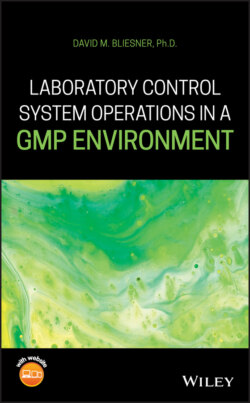Читать книгу Laboratory Control System Operations in a GMP Environment - David M. Bliesner - Страница 12
1 Introduction to the Quality Systems Based Approach to CGMP Compliance Overview of Quality Systems and the Laboratory Control System
ОглавлениеThe US Food and Drug Administration (US FDA) mandates that a drug firm, and therefore the laboratory, be operated in a state of control by employing conditions and practices that assure compliance with the intent of the Federal Food, Drug, and Cosmetic Act and portions of the Current Good Manufacturing Practice (CGMP) regulations (e.g. 21 CFR Parts 210 and 211) that pertain to it. Activities found in drug firms, including operation of the laboratory, can be organized into systems that are sets of operations and related activities. Control of all systems helps to ensure the firm will produce drugs that are safe, have the proper identity and strength, and meet the quality and purity characteristics as intended [1, 2].
For drug firms, FDA has outlined the following general scheme of systems that impact the manufacture of drugs and drug products:
1 Quality System. This system assures overall compliance with CGMPs and internal procedures and specifications. The system includes the quality control (QC) unit and all of its review and approval duties (e.g. change control, reprocessing, batch release, annual record review, validation protocols, reports, etc.). It also includes all product defect evaluations and evaluation of returned and salvaged drug products. (See the CGMP regulation, 21 CFR 211 subparts B, E, F, G, I, J, and K.)
2 Facilities and Equipment System. This system includes the measures and activities that provide an appropriate physical environment and resources used in the production of the drugs or drug products. It includes:Buildings and facilities along with maintenance.Equipment qualifications (installation and operation); equipment calibration and preventative maintenance; and cleaning and validation of cleaning processes as appropriate. Process performance qualifications are included as part of process validation, which is done within the system where the process is employed.Utilities that are not intended to be incorporated into the product such as heating, ventilation, and air-conditioning (HVAC), compressed gases, steam, and water systems. (See the CGMP regulation, 21 CFR 211 subparts B, C, D, and J.)
3 Materials System. This system includes measures and activities to control finished products and components including water or gases that are incorporated into the product, containers, and closures. It includes validation of computerized inventory control processes, drug storage, distribution controls, and records. (See the CGMP regulation, 21 CFR 211 subparts B, E, H, and J.)
4 Production System. This system includes measures and activities to control the manufacture of drugs and drug products including batch compounding, dosage form production, in-process sampling and testing, and process validation. It also includes establishing, following, and documenting performance of approved manufacturing procedures. (See the CGMP regulation, 21 CFR 211 subparts B, F, and J.)
5 Packaging and Labeling System. This system includes measures and activities that control the packaging and labeling of drugs and drug products. It includes written procedures, label examination and usage, label storage and issuance, packaging and labeling operations controls, and validation of these operations. (See the CGMP regulation, 21 CFR 211 subparts B, G, and J.)
6 Laboratory Control System. This system includes measures and activities related to laboratory procedures, testing, analytical method development, validation and/or qualification/verification, and the stability program. (See the CGMP regulation, 21 CFR 211 subparts B, I, J, and K.)
According to FDA, “The Quality System provides the foundation for the manufacturing systems that are linked and function within it.” Graphically, the scheme of systems looks like [1] (Figure 1.1):
This approach is commonly referred to as the six-system model and is still used today by FDA to conduct inspections of good manufacturing practice (GMP) facilities.
As stated in (6) earlier, FDA considers a firm's Laboratory Control System (LCS) to be a key element in CGMP compliance. Within the LCS are at least 10 additional sub systems or sub elements, which may include:
Laboratory Managerial and Administrative Systems (MS)
Laboratory Documentation Practices and Standard Operating Procedures (OP)
Laboratory Equipment (LE)
Laboratory Facilities (LF)
Method Validation and Method Transfer (MV)Figure 1.1 FDA guidance for Industry Quality Systems approach to pharmaceutical CGMP regulations, September 2006 [1].
Laboratory Computer Systems (LC)
Laboratory Investigations (LI)
Data Governance and Data Integrity (DI)
Stability Program (SB)
General Laboratory Compliance Practices (CP)
These 10 sub elements of the LCS are not part of any guideline document, international council, or inspection convention. Instead they have been created by the author, to promote the establishment and maintenance of Quality Systems and sub systems, which demonstrate you are in control of your laboratory operations and thus in compliance with the CGMP regulations.
These 10 sub element topics constitute 10 chapters within this book. Each chapter will describe the critical functions of the LCS sub element so the reader understands what is expected from the US FDA and other Global Regulatory Agencies.
A listing of the primary Global Regulations, the Agencies that enforce them, and the international councils or inspection conventions that help to harmonize their efforts are listed in the succeeding text.
